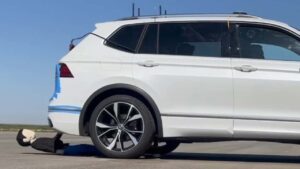NHTSA Bailment: Potentially saving 360 lives annually and preventing 24,000 injuries.
Advancements in technology have significantly transformed the safety features of automobiles. Contemporary cars are now equipped with sensors and software that enable them to perceive their surroundings by recognizing lane markers, traffic signs, other vehicles, and pedestrians. The National Highway Traffic Safety Administration (NHTSA) has proposed a new regulation that would require all new vehicles to be equipped with automatic emergency braking systems that meet higher standards.
By 2029, a new regulation is set to be implemented in the United States, which will necessitate that all newly-sold light vehicles come equipped with three specific technologies: forward collision warning, automatic emergency braking, and pedestrian automatic emergency braking. The National Highway Traffic Safety Administration (NHTSA) estimates that enforcing these technologies could potentially save a minimum of 360 lives annually and avoid at least 24,000 injuries.
Fortunately, car manufacturers are making great progress in providing these features as standard in vehicles, driven by a collective effort to enhance safety.
Towards the end of last year, 20 car manufacturers fulfilled the commitment set by the Insurance Institute for Highway Safety to install automatic emergency braking in over 95 percent of the cars they make in the United States. Consumer Reports announced in 2019 that car makers hoping to receive its Top Picks award must include pedestrian automatic emergency braking in their vehicles.
The latest Federal Motor Vehicle Safety Standard regulation goes beyond just mandating certain features. It also outlines particular situations in which the systems must function correctly.
All vehicles must have the capability to come to a halt at speeds of 62 miles per hour in order to prevent crashes with other vehicles. They also need to be able to detect pedestrians in both daylight and nighttime conditions. Additionally, the system will be mandated to activate the brakes at speeds of up to 90 miles per hour when it senses an impending collision with another vehicle, and at speeds of up to 45 mph when a pedestrian is detected.
Source: NHTSA







Simply wish to say your article is as amazing The clearness in your post is just nice and i could assume youre an expert on this subject Well with your permission let me to grab your feed to keep updated with forthcoming post Thanks a million and please carry on the gratifying work
I simply could not go away your web site prior to suggesting that I really enjoyed the standard info a person supply on your guests Is going to be back incessantly to investigate crosscheck new posts
I found your blog web site on google and test a couple of of your early posts. Proceed to maintain up the superb operate. I simply extra up your RSS feed to my MSN News Reader. Looking for forward to reading more from you later on!?
Howdy! Do you know if they make any plugins to safeguard against hackers? I’m kinda paranoid about losing everything I’ve worked hard on. Any recommendations?